A swimmer’s body is achieved through consistent swimming workouts, strength training, a balanced diet, and proper recovery. This combination creates the lean, muscular, and athletic build that swimmers are known for.
Why does it matter? The swimmer’s physique is not only visually appealing but also functional—strong, symmetrical, and highly conditioned for endurance. Unlike bulkier builds, it emphasizes balance, agility, and stamina, making it both aesthetic and performance-driven.
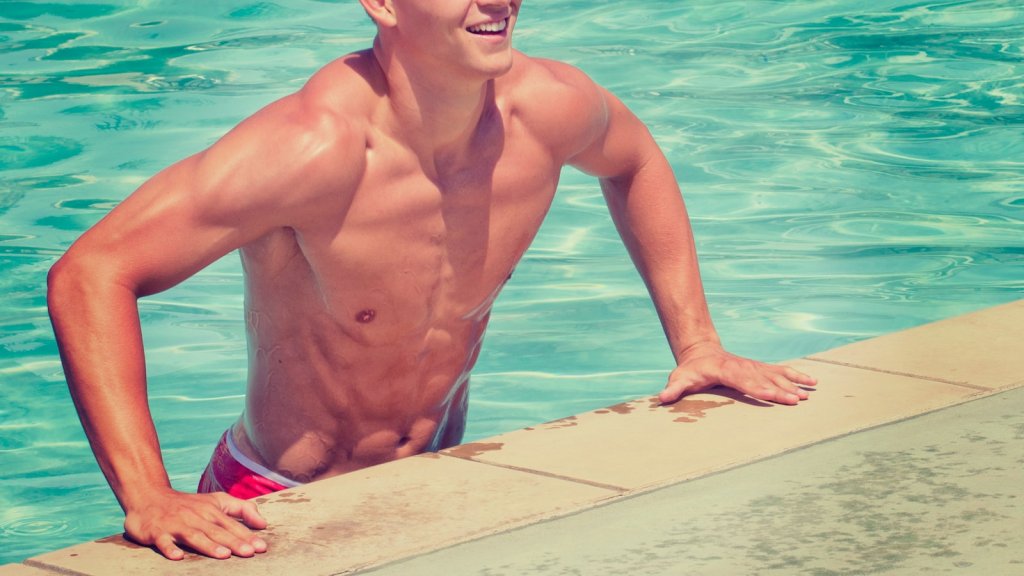
To develop a swimmer’s body, you’ll need to combine:
- Swim workouts for cardiovascular conditioning and muscle engagement.
- Dryland strength training to improve power and shape.
- Balanced nutrition to fuel workouts and promote muscle recovery.
- Hydration and recovery habits to support endurance and prevent burnout.
- Lifestyle choices like quality sleep and stress management.
👉 In this guide, we’ll break down exactly how training, diet, and lifestyle come together to help you build and maintain a swimmer’s body.
What Does a Swimmer’s Body Look Like?
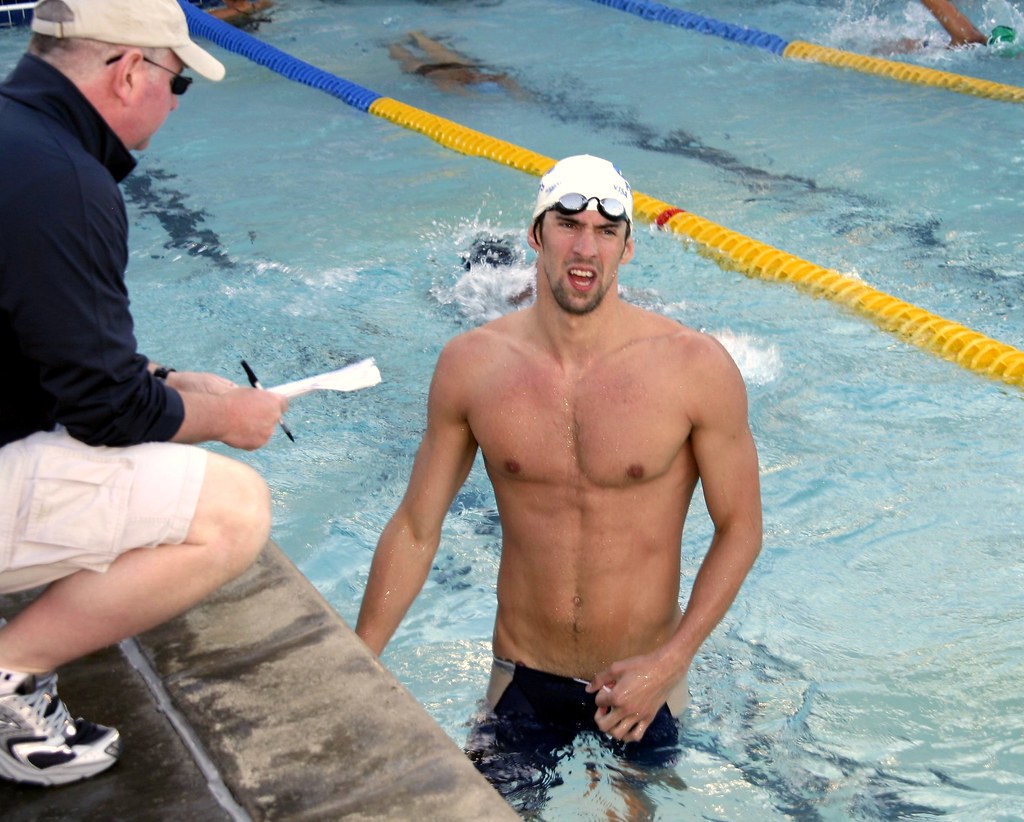
A swimmer’s body is typically lean, muscular, and defined by a strong upper body, toned core, and powerful legs. Unlike bulky weightlifters, swimmers develop a streamlined physique that combines strength with endurance.
Key Traits of a Swimmer’s Body
- V-Taper Shape: Broad shoulders tapering down to a narrow waist create the classic “swimmer’s silhouette.” This is developed through repetitive pulling motions in the water that strengthen the lats, traps, and shoulders.
- Toned Muscles: Swimmers build long, lean muscle rather than short, bulky muscle fibers. This happens because water provides continuous resistance, requiring muscles to contract and extend fully during each stroke.
- Low Body Fat: Competitive swimmers usually maintain lower body fat percentages (around 8–12% for men and 13–18% for women) to enhance buoyancy and speed in the water.
- High Endurance: Their bodies are not just strong but also highly conditioned for stamina, with efficient cardiovascular systems and strong lung capacity.
Competitive vs. Casual Swimmers
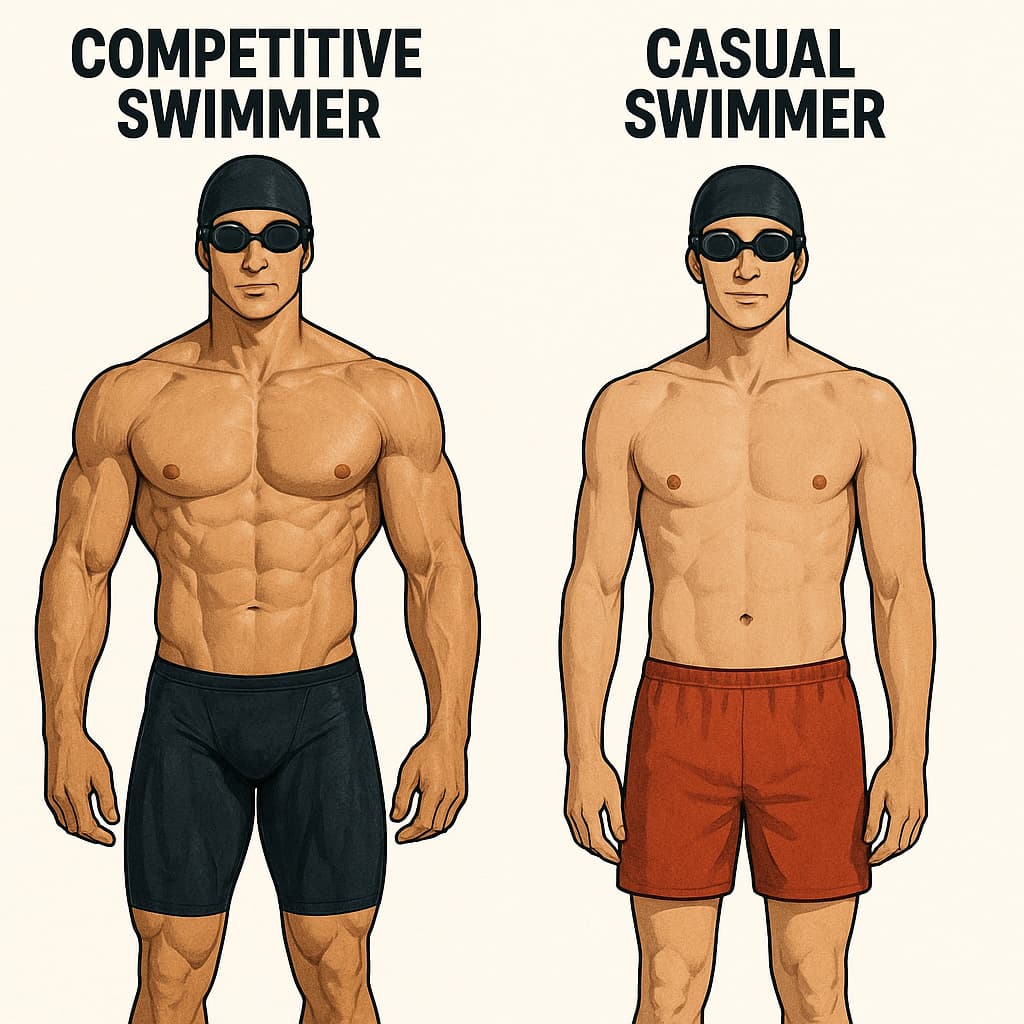
- Competitive swimmers often train 2–4 hours a day, combining pool sessions with dryland strength workouts. Their physiques are more pronounced, with well-developed shoulders, arms, and core.
- Casual swimmers still benefit from improved muscle tone and fitness but may not have the same dramatic V-taper or ultra-low body fat. Even moderate swimming a few times a week can lead to a leaner, fitter build compared to non-swimmers.
Why Swimming Builds Unique Musculature
Swimming is unlike any other workout because:
- Full-body resistance: Water is about 800 times denser than air, so every movement becomes resistance training. This sculpts long, lean muscles while improving flexibility.
- Balanced muscle engagement: Each stroke recruits multiple muscle groups simultaneously—back, shoulders, arms, chest, core, and legs—creating symmetry and balance in the body.
- Low-impact conditioning: Unlike running or weightlifting, swimming is joint-friendly, allowing high training volume without excessive wear and tear, which encourages consistent training over time.
👉 In short, the swimmer’s body is athletic, functional, and aesthetically pleasing—a result of combining strength, cardio endurance, and low-impact conditioning in a single workout.
Benefits of a Swimmer’s Body
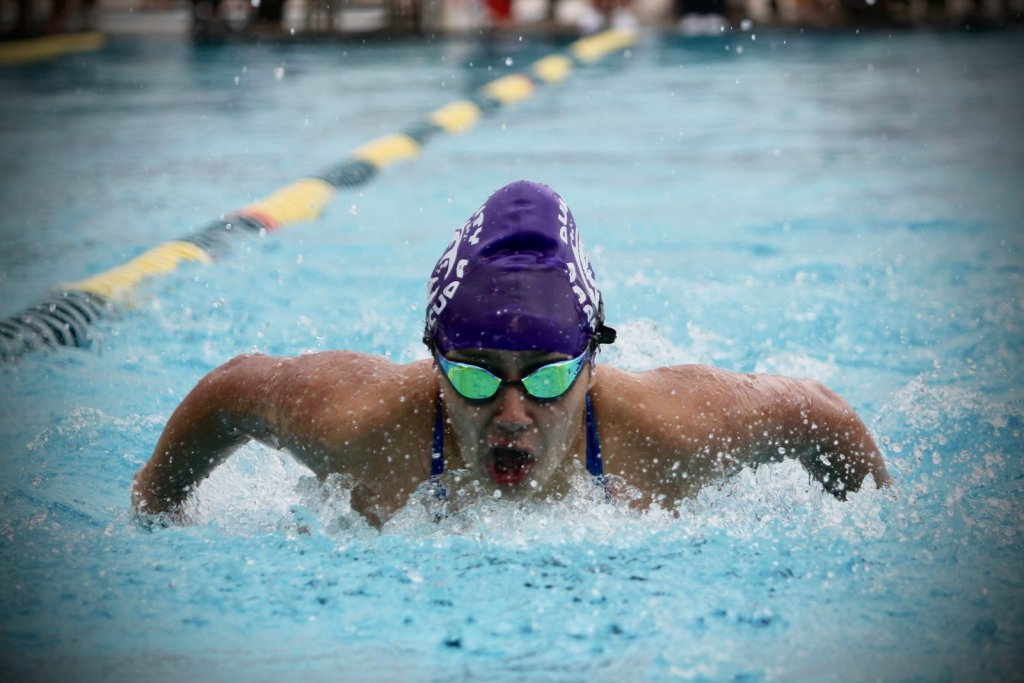
- Full-Body Strength: Swimming develops broad shoulders, strong arms, powerful legs, and a stable core.
- Cardiovascular Fitness: Regular swimming improves heart and lung capacity, supporting long-term endurance.
- Low Body Fat & Lean Muscle: Consistent training promotes a toned, athletic look with efficient calorie burning.
- Joint-Friendly Training: Swimming is low-impact, reducing stress on knees, hips, and spine compared to running or heavy lifting.
- Better Posture & Flexibility: Strong back and core muscles improve alignment, while wide stroke movements enhance mobility.
- High Calorie Burn: A vigorous swim can burn 400–700 calories per hour, aiding weight management.
- Mental Health Benefits: Swimming reduces stress, boosts mood, and improves sleep quality.
- Longevity & Injury Prevention: Balanced muscle development and low-impact exercise support long-term health and reduce injury risks.
👉 According to Harvard Health, swimming is one of the most effective full-body workouts for both physical and mental well-being.
Training for a Swimmer’s Body
Building a swimmer’s body requires more than just laps in the pool. The right mix of swimming workouts, strength training, and recovery creates the lean, muscular physique swimmers are known for. Whether you’re training competitively or simply want the aesthetic, here’s how to structure your workouts.
Swim Workouts
Swimming itself is the foundation. It combines cardio, resistance, and flexibility in one workout. Each stroke targets different muscles:
- Freestyle: Strengthens shoulders, chest, and core.
- Backstroke: Builds back muscles and improves posture.
- Butterfly: Engages chest, arms, and abs while boosting power.
- Breaststroke: Works inner thighs and improves coordination.
For best results:
- Aim for 3–4 swim sessions per week.
- Mix endurance sets (longer, steady laps) with sprint intervals (short, high-intensity bursts).
- Use tools like kickboards, pull buoys, or paddles to isolate and strengthen specific muscle groups.
👉 According to USA Swimming (2024), combining endurance and sprint sessions helps athletes build both aerobic capacity and muscular power.
Strength & Dryland Training
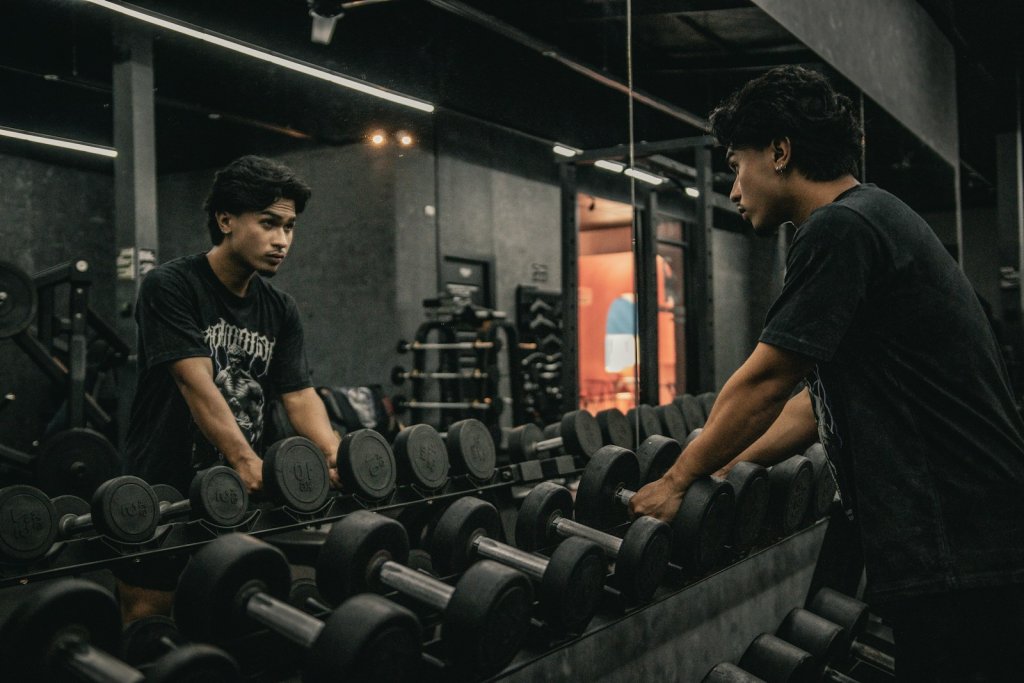
Swimming alone won’t give you the full swimmer’s body. Strength training is essential to sculpt muscles and prevent imbalances.
- Upper Body: Pull-ups, push-ups, dumbbell rows for stronger shoulders and lats.
- Core: Planks, Russian twists, leg raises to improve stability in the water.
- Lower Body: Squats, lunges, calf raises to boost kick power.
- Resistance Bands: Mimic swim strokes on land for muscle activation.
Most experts recommend 2–3 strength sessions per week, lasting 30–45 minutes. A 2023 study from the Journal of Strength & Conditioning Research found that swimmers who added dryland training improved both performance and physique compared to swimming alone. You can explore detailed dryland workout guides at MySwimPro.
Consistency & Recovery
Even the best workouts fail without consistency and recovery. Muscles grow and adapt outside the pool.
- Train consistently (at least 4–5 total workouts weekly, mixing pool + strength).
- Prioritize recovery: 7–9 hours of sleep supports muscle repair.
- Schedule rest days to prevent overtraining and burnout.
- Stretch & mobility: Yoga or dynamic stretches help maintain a wide range of motion and reduce injury risk.
👉 The American Council on Exercise highlights that proper recovery reduces injuries and improves long-term performance in swimmers.
✅ Takeaway: To get a swimmer’s body, combine swim workouts, strength training, and proper recovery. Skipping one of these pillars often leads to slower progress or injury.
Diet and Nutrition Tips for a Swimmer’s Body

A swimmer’s body isn’t built in the pool alone—it’s also shaped in the kitchen. The right diet fuels intense workouts, repairs muscles, and helps maintain a lean, toned physique. To maximize training results, swimmers should focus on balanced macronutrients, smart meal timing, and hydration.
Macronutrient Balance
- Carbohydrates (50–60% of daily calories): Carbs are the primary energy source for swim workouts. Whole grains, fruits, and vegetables keep glycogen stores full for endurance. UPMC Sports Medicine notes that swimmers often need higher carb intake than non-athletes.
- Protein (1.4–1.8 g per kg of body weight): Essential for repairing muscle breakdown from swimming and strength training. Lean meats, eggs, fish, beans, and Greek yogurt are excellent sources.
- Healthy fats (20–30% of daily calories): Avocados, nuts, seeds, and fatty fish help with hormone regulation, joint health, and recovery.
Meal Timing & Frequency
Proper timing ensures your body has energy to perform and recover:
- Pre-swim meal (2–3 hours before): Balanced carbs + protein. Example: oatmeal with banana and peanut butter.
- Quick pre-swim snack (30–60 minutes before): Easily digestible carbs such as a banana, granola bar, or toast with honey.
- Post-swim recovery (within 30 minutes): A mix of carbs and protein (3:1 ratio) to restore glycogen and repair muscles. Chocolate milk or a protein shake with fruit are simple options. According to Speedo, this timing is critical for reducing soreness and speeding recovery.
- Frequent meals: 4–6 smaller meals spread throughout the day maintain energy and prevent overeating.
Hydration & Electrolytes
Even though you’re surrounded by water, swimming leads to significant fluid loss through sweat.
- Drink water consistently throughout the day—not just during workouts.
- For sessions longer than 60 minutes, add sports drinks with electrolytes to replace sodium and potassium. The American College of Sports Medicine emphasizes electrolyte replacement for athletes training in high volume.
Common Diet Mistakes to Avoid
- Skipping meals: Leads to fatigue, poor performance, and slower recovery.
- Overeating processed foods: Sugary snacks or fried foods can add excess calories without fueling performance.
- Neglecting protein after training: Missed recovery meals reduce muscle repair and strength gains.
👉 For a full breakdown of what to eat before, during, and after workouts, check ISSN’s Sports Nutrition Guidelines.
✅ Takeaway: The swimmer’s body depends on a high-carb, moderate-protein, healthy-fat diet, paired with proper hydration and recovery meals. Eating smart ensures that your pool and gym efforts translate into a lean, powerful physique.
Lifestyle & Recovery Habits
Training and diet may build the foundation of a swimmer’s body, but recovery and lifestyle habits are what allow your muscles to adapt, grow, and stay injury-free. Without proper rest, even the best workouts can lead to burnout or plateaus.
Sleep: The Secret Recovery Tool
- Aim for 7–9 hours of quality sleep per night. This is when your body repairs muscle tissue, balances hormones, and restores energy.
- According to the National Sleep Foundation, athletes who get sufficient rest perform better, recover faster, and have lower injury risks.
Stretching & Mobility Work
- Swimming demands a wide range of motion, especially in the shoulders and hips.
- Include dynamic stretching before workouts (arm circles, leg swings) and static stretching afterward to keep joints flexible.
- Yoga or Pilates can improve flexibility, posture, and core stability—all critical for efficient swimming.
Active Recovery Days
- Instead of complete rest, try light activities like walking, cycling, or yoga on off-days.
- These keep blood flowing, speed up recovery, and reduce muscle stiffness.
Stress Management
- High stress can increase cortisol levels, interfering with muscle recovery and fat loss.
- Practices like deep breathing, meditation, or mindfulness can lower stress and improve consistency.
- The American Psychological Association notes that regular stress management improves overall athletic performance.
Avoiding Overtraining
- Signs of overtraining include constant fatigue, irritability, and declining performance.
- Schedule at least 1–2 rest days per week and listen to your body’s signals.
- As highlighted by ACE Fitness, balancing intense sessions with recovery ensures steady progress and long-term health.
✅ Takeaway: A swimmer’s body isn’t built by workouts alone—it’s sustained through sleep, stretching, active recovery, stress management, and balanced training loads. Lifestyle habits make the difference between short-term results and long-term transformation.
Sample Weekly Plan for a Swimmer’s Body
Creating a swimmer’s body requires balancing swim sessions, dryland strength training, and recovery. This sample weekly plan combines all three elements to help you build endurance, strength, and lean muscle while avoiding burnout.
Weekly Training Schedule
| Day | Workout Focus | Example Session |
|---|---|---|
| Monday | Swim Endurance | 45–60 min steady laps (freestyle & backstroke). Add kickboard drills for leg strength. |
| Tuesday | Strength Training | Full-body workout: pull-ups, squats, planks, dumbbell rows (30–45 min). |
| Wednesday | Swim Intervals | 10×100m sprints with rest between sets + technique drills. |
| Thursday | Active Recovery | Yoga, light cycling, or stretching (30 min). Focus on mobility. |
| Friday | Strength & Core | Resistance band swim pulls, push-ups, lunges, Russian twists. |
| Saturday | Mixed Swim Session | 60 min with all four strokes (freestyle, backstroke, butterfly, breaststroke). End with cool-down laps. |
| Sunday | Rest Day | Prioritize sleep, hydration, and meal prep for the week ahead. |
Tips to Maximize Results
- Warm up & cool down: Always start with 5–10 min of light swimming or stretching to prevent injury.
- Hydrate: Even short sessions deplete fluids. The American College of Sports Medicine stresses consistent hydration for athletes.
- Track progress: Note lap times, weight lifted, or weekly endurance improvements.
- Listen to your body: If you feel persistent fatigue, swap a workout for active recovery.
Why This Plan Works
- Swimming sessions build cardiovascular endurance, sculpt shoulders, back, and core.
- Strength training ensures balanced muscle development and boosts power in the pool.
- Recovery days protect against overtraining and improve long-term performance.
- According to USA Swimming, consistent training paired with structured rest leads to the most effective adaptations.
✅ Takeaway: Following a weekly plan that balances swimming, strength, and recovery is the fastest way to achieve the lean, athletic swimmer’s body. Consistency matters more than intensity—stick to the routine, and results will follow.
FAQs About Getting a Swimmer’s Body
1. How long does it take to get a swimmer’s body?
It depends on your current fitness level and consistency. Most people see visible changes in 8–12 weeks of regular swimming and strength training. Competitive swimmers train for years to perfect their physique. The key is consistency and progressive overload, not quick fixes.
2. Can you get a swimmer’s body without swimming?
Yes, but it’s harder. Strength training, rowing machines, resistance band swim pulls, and HIIT cardio can mimic some of the benefits. However, swimming provides unique resistance and joint-friendly cardio that’s difficult to fully replace. For best results, combine both.
3. Do swimmers lift weights?
Absolutely. Elite swimmers supplement pool workouts with 2–3 strength sessions per week. This prevents muscle imbalances, boosts power, and protects against injury. MySwimPro notes that dryland strength training is a core part of modern swim programs.
4. What should swimmers eat daily?
A balanced swimmer’s diet includes:
- Carbohydrates (50–60%) for fuel.
- Protein (1.4–1.8 g per kg of body weight) for recovery.
- Healthy fats (20–30%) for joint health and hormone balance.
Hydration and electrolytes are equally important. UPMC Sports Medicine recommends eating every 3–4 hours to maintain energy levels.
5. How much cardio is needed for a swimmer’s body?
Most swimmers train 3–5 times per week, with sessions lasting 45–90 minutes. You don’t need to match elite training volumes, but consistent cardio combined with resistance training helps build endurance and lean muscle.
6. Is a swimmer’s body healthy long-term?
Yes. A swimmer’s body typically has low body fat, strong muscles, and excellent cardiovascular fitness. Swimming is low-impact, making it one of the best lifelong activities for joint health and weight management. According to the Centers for Disease Control and Prevention, swimming improves heart health and reduces chronic disease risk.
Conclusion: Building Your Swimmer’s Body
The swimmer’s body is not built overnight—it’s the result of consistent swim training, smart strength workouts, balanced nutrition, and recovery-focused lifestyle habits. By combining these pillars, you can develop the broad shoulders, strong core, and lean muscles that define this athletic physique.
Remember:
- Swim regularly, mixing endurance and sprint sessions.
- Add dryland strength training 2–3 times per week.
- Fuel your body with high-quality carbs, protein, and healthy fats.
- Prioritize sleep, hydration, and stress management for long-term progress.
As USA Swimming highlights, improvement comes from steady dedication, not shortcuts. Stick with your plan, adjust as you grow stronger, and trust the process.
✅ Call-to-action: Start today with a simple swim workout and clean meal plan—your swimmer’s body will take shape one stroke and one healthy habit at a time.
